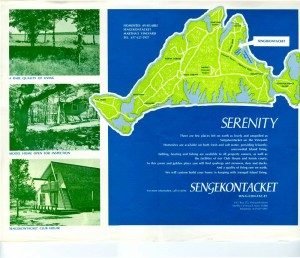The Early Days
The story of Sengekontacket is a stormy, tragic story, which included a number of the Island characters, four friends that acquired the land, two extraordinary Boston attorneys, and then junior Senator Edward Kennedy. It was a story that reached all the way to Washington. In the background were real estate booms in the United States and on Martha’s Vineyard following a stock market crash in 1969. Internationally, the United States involvement in the Vietnam War was winding down amid riots and protests.
The prime motivator behind the project that became the Sengekontacket Community was William Sawyer.
Bill was the CEO of a very progressive and well-known federal savings bank outside of Boston. Tracing his roots back to the whaling days and with close connections to all of the local fishing characters on Martha’s Vineyard as a result of his extensive swordfishing pursuits, Bill convinced three associates to acquire the 135 acres that would comprise the community. Harrison Street Corporation (Bill’s home address in Duxbury, Massachusetts) acquired the property that year.
Bill immediately engaged Sasaki Dawson and DeMay (now Sasaki Associates) to undertake the land planning for the project. Sasaki was at the forefront of the planned unit development/open space concepts seeking to replace the typical grid subdivision plans used by most developers. Their final plan included 108 condominiums and 59 house lots. It would not be completed according to plan.
Bob Connelly, a Boston area residential builder, became the member with the responsibility to get the project constructed. Construction commenced in 1971 and was rolling along when it abruptly ground to a halt in the spring of 1972. Tragedy first struck the Sales Director. Taking his father and his two children out fishing in his thirteen-foot whaler, a sudden violent northeaster squall hit them only a mile out from Sengekontacket pond. The Whaler capsized. Quickly securing a line to his two children and father, he decided to swim them to shore. He was a very strong swimmer and made it to shore, towing and unfortunately drowning his father and children in the process. A broken man, he left that Fall.
In April 1972 a second blow hit the project. Senator Edward Kennedy, seeking to burnish his tarnished reputation, filed an “Islands Trust” bill, which effectively stopped all development on Nantucket and Martha’s Vineyard. “… the Kennedy bill would impose an unprecedented degree of federal control through the creation of the nation’s first “island trust”-a sort of combination public recreation area and private preserve.” Sengekontacket fell into the scenic preservation zone, which meant private owners could keep their land, but never develop it! With twenty-four condominiums under construction, most of the roadwork and utilities in, the four partners were facing a major disaster.
The Island elite loved the Kennedy bill. The local fisherman, retailers, and workers that lived off the summer tourists saw exactly what it meant for them. Attacks and defenses were acrimonious and Kennedy made some slight amendments. As fall approached, Sawyer went into action. Bill had two prominent Boston attorneys on his bank board of directors. One handled the Republican issues and one took care of the Democratic issues. Early in 1972, Bill also hired a financial and real estate professional to fill both slots left by his departing president and vice president-lending. The lawyers took on the lobbying effort and Sawyer’s new number two went after the workout plan for Sengekontacket. In the spring of 1973, it was decided to float a very creative rumor, which gained wide credibility. To wit, Kennedy’s amendments were really designed to create a new national park complete with a bridge from Wood’s Hole to Vineyard Haven. That did it. Even the elites couldn’t back that. The bill quietly died.
Construction started again only to meet the third tragedy of the early years. The first Arab oil embargo and formation of OPEC finally hit the United States in full force. Development everywhere ground to a halt. Poorly structured projects collapsed immediately. Good projects also died. Sales at Sengekontacket ceased. The partners began quarreling among themselves. In a tense meeting with lawyers ready to “shoot”, the four partners listened to Bill’s number two present his workout plan. Fifteen linear feet of spreadsheets later, they reluctantly accepted the conclusions. Six months later, the project was mostly sold, the partners were clear of their obligations, and Sengekontacket Community Corporation was turned over to the membership.
As a postscript, prior to turning the project over to the members, Bill’s workout specialist tried to get the partners to shift the remaining 84 condominium unit permits to the crest of the hill where they really belonged. The partners were exhausted, were clear of lending obligations, and wanted no further involvement. The condominium lots were converted to three residential lots and the condo permits were allowed to lapse. He made a last pitch to an early meeting of members asking them to look into the future and buy the lots on each side of the community dockland. The cost was $500 per member spread over five years. The proposal failed and Sengekontacket entered existence in its present form–sixty-three lots and twenty-four condominiums.
Written from recollections by:
C. L. Gildroy
September 7, 2008

